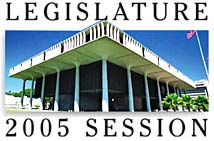Anti-poverty money
used to buy ads
» Legislators question whether
a $1 million anti-drug campaign
is proper use of funds
» A state official defends the program, saying
the spots help people emerge from poverty
State legislators are questioning whether $1 million originally intended for anti-poverty programs was properly spent in an anti-drug and alcohol abuse publicity campaign being run out of Lt. Gov. James "Duke" Aiona's office.
But the Lingle administration contends federal funding guidelines allow the money to be used for the anti-drug campaign, which features decathlete Bryan Clay, singer Jasmine Trias and surfer Bethany Hamilton.
|
|
"This is something that we are not concerned about. They indicated that it would be a survey to see if an audit was warranted," Koller told the Star-Bulletin.
The federal guidelines say the money must go to help poor families, promote self-sufficiency through job training and marriage, prevent unwanted pregnancies and encourage the formation of two-parent families.
At the hearing, Sen. Willie Espero (D, Ewa-Kapolei-Ewa Beach) questioned the federal money going to a publicity campaign.
"Are you saying that advertising is better than programs?" Espero said. "Why aren't we putting more counselors in the schools instead of having a nice, slick Madison Avenue campaign? We don't need to pat ourselves on the back like the lieutenant governor."
So far, $513,000 has been spent under a planned $1 million campaign run out of Aiona's office.
The public relations and advertising firm Communications Pacific got the largest portion, $85,000. An additional $265,000 went to the four major Honolulu television stations.
The Honolulu Advertiser got $10,000, and MidWeek Printing, owned by Oahu Publishing, which also owns the Star-Bulletin, received $6,000.
The television spots featured the young local celebrities. The ads also said they were sponsored by Aiona and the state Department of Human Services, without any mention that the funds came from a federal anti-poverty program.
Kauai Sen. Gary Hooser also complained about the program, saying: "This could have been spent on other needy programs. We could have spent it to fund Planned Parenthood."
Koller defended the campaign, saying it was considered "a good way to get people out of poverty."
Legislators, however, were also concerned because Koller and Gov. Linda Lingle were using TANF funds in place of state funds authorized for state Foundation for Culture and the Arts programs.
Last July, Lingle chopped $500,000 from the State Foundation on Culture and Arts biennium grants program budget that had been promised $1.1 million by the Legislature.
After a public outcry, Lingle substituted TANF federal dollars for the state money. Lingle used a portion of the money for youth service centers. Included in those service center budgets was money that previously came from the state culture and arts funds.
The federal government is also looking into how the state spends the federal money, and has ordered a general audit of the anti-poverty program.
On Jan. 10 the federal Office of the Inspector General notified the state that an audit would be conducted later this month "to determine if costs incurred by the state under TANF in state fiscal years 2004 and 2005 complied with federal requirements." The federal audit was requested by Sharon Fujii, regional administrator for the federal Administration for Children and Families.
Koller said that under federal guidelines the state can collect up to $98 million a year in TANF funds.
Koller said the "federal government always audits programs, and we think it is permissible."
"If we disagree with what was done here, what do you suggest we do?" asked Sen. Brian Taniguchi, chairman of the Ways and Means Committee, at the hearing.
"When we appropriated $500,000 to culture and arts, it was our intent that the money be spent that way," Taniguchi (D, Manoa) said.
Koller told the Star-Bulletin the Lingle administration was trying to find the "best ways to take advantage of the TANF money."
In a report to the Legislature, Koller said the Lingle administration has been more creative than past state leaders in using the TANF funds.
"This annual block grant has been available to the state for spending since July 1, 1997. However, for reasons that I do not fully comprehend, the prior administration and the Legislature did not expend the full amount, despite the hard economic times, and chose to eliminate important services for the poor that could have been funded," Koller said.
www.ehawaiigov.org
[News] [Business] [Features] [Sports] [Editorial] [Do It Electric!]
[Classified Ads] [Search] [Subscribe] [Info] [Letter to Editor]
[Feedback]

